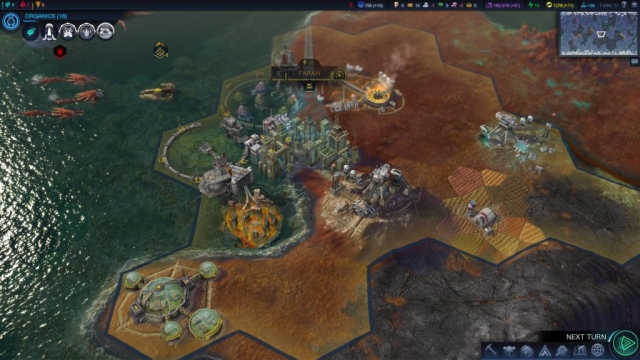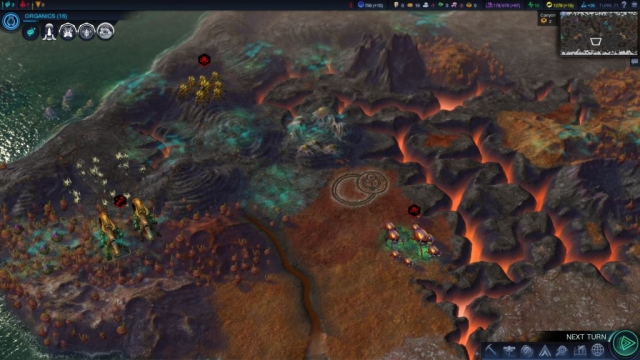Sid Meier’s Civilization: Beyond Earth – Rising Tide

The big criticism of Beyond Earth when it came out was that is felt like a Civilization V mod. On the one hand, that speaks well of the modding community, and mod support, of Civ 5 that such a claim could be made so casually. But on the other hand, it’s clear that people were expecting more out of Beyond Earth. Now that the Rising Tide expansion is out, there’s really only one question it needs to answer: does it finally feel like its own game? The answer, I think, is a hesitant “yes”.
Rising Tide doesn’t alter Beyond Earth’s usual flow all that much; you’re still setting down on a hostile world teeming with aliens. The new primordial and arctic biomes are a nice addition to the mix, but the novelty of new biomes isn’t going to stick past your first games on them. As such, they are probably the least replay-value-adding aspect of the expansion. Still, fighting against reskinned versions of the aliens we’ve all grown to love (and hate) is also a nice change of pace. The new biome descriptions said that aliens will act differently depending on the climate, but I didn’t notice a huge variation.
If you’re one of the new factions that hews towards water, you also get a chance to thruster down directly into the sea and construct your first city on coastal waters, which is the big new selling point – seasteading cities! Personally, I would have preferred Rapture-style underwater cities, but this is fine too. And indeed, the most interesting aspect to these floating communities is that you can move them around in the water, like a giant, lumbering ship. It costs production and turns to do so, but it’s the only means (besides using energy/money) to acquire new land/water tiles, so it ends up being a must.
To go along with the new sea-cities is the ability for your workers to farm and mine the water. All taken together, this becomes a double-edged sword for Beyond Earth. While it is cool that by the end of the game, the whole map is covered in hydroponics and deep-sea mining complexes, thus giving it an even more futuristic look, it also takes away a large part of the strategy. By mid-game, there’s really not much difference between land and water, and continents start to lose their importance. Hell, by late game, most land units can even hover over water and act as naval units, so by the end, the distinction between land and sea is almost moot. Yes, that fits in with the futuristic vision of the game, but it makes the strategy a little less compelling.
The new diplomacy architecture is similarly one step forward, one step back. Now, instead of getting “favor points”, you generate “diplomatic capital”, which can be used either on yourself (to give your faction various small bonuses), to buy units and buildings at a large mark-up, or to initiate various capital-for-bonus deals with other factions. Much like faith from Civ 5, diplomatic capital adds another type of currency to the game and all of the choices related to it are fun and interestingly tough calls to make.
The problem is that in adding this new facet, developer Firaxis also gutted the old diplomatic system. Now, all of your relations exist on a sliding scale wherein, like The Sims, other leaders watch your actions and decide which things they like about you and which they don’t. From there, it’s easier or harder to maintain that co-operation agreement you just signed. But gone are the options to demand that neighbors make peace with each other. Or tell an aggressive expansionist to not settle near you. In short, almost all of the diplomacy is now “streamlined” and most of the role-playing elements are gone.
Everything else in Rising Tide is all about small touches. There is a plentiful bounty of new units dispersed throughout, including the new universal unit, the melee-range patrol boats. But where the expansion units truly shine is in the hybridizing of affinities. It’s no longer as much of a waste to diversify yourself between Supremacy, Purity and Harmony. Now, if you can hit parity between two of them, you get access to hybrid units, which not only look different, but also come with bonuses that the specialized affinity units can’t touch. They aren’t make-or-break, but it definitely made me think twice before gunning down the Purity path, full-bore.
Among the final touches is an updated UI, which finally adds a generous helping of color to the tech web, thus making it much easier to tell a unit from a building from a wonder. The game has also been rebalanced for all of the new content, such that old Beyond Earth strategies must be either heavily tweaked or thrown out entirely in favor of new approaches. This is great, if for no other reason than it’s fun to rediscover how to play a game you thought you had mastered already. Lastly, the new music is just as amazing as the vanilla game’s. Long after I’ve grown tired of playing Beyond Earth, I’ll still always remember the soundtrack and will keep it on my playlist for those car rides when I want to feel inspired.
All in all, Rising Tide is a decent addition to Beyond Earth, and yes, it finally feels like a game that has achieved escape velocity and left the atmosphere and gravitational pull of planet Civ 5. Even if it never receives another expansion, this version of Beyond Earth is now a should-play entry in the Civilization series and should easily hold everyone’s attention long enough for Civilization 6’s announcement
Reviewed By: Brian Mardiney
Publisher: 2K Games
Rating: 80%
——————————————————————————–
This review is based on a digital copy of Sid Meier’s Civilization: Beyond Earth – Rising Tide for the PC provided by 2K Games.
 Game Over Online
Game Over Online




